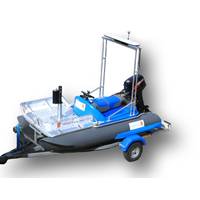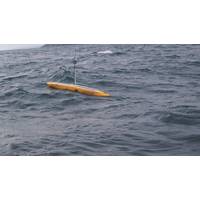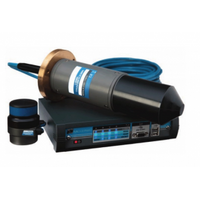
Tech File: Kongsberg’s Compact Survey Vessel
. It measures 3m in length, has a width of 1.62m and weights 182kg which includes the supplied 30HP outboard engine. Standard fuel capacity is 24L which gives the Compact Survey Vessel the ability to operate for many hours before the need to refuel. With a top speed of 27 knots it can quickly get from launch site to survey area. The vessel has a draft of just 0.35m so can operate in extreme shallow environments and by utilizing the GeoSwath 4R system it can quickly map bathymetry and record geo referenced side scan data. The GeoSwath transducer is mounted on a retractable pole with pre-installed

Kongsberg Launches Complete Survey Vessel
is effective in a wide range of shallow survey applications. Its shallow draft, high top speed and manoeuvrability combined with the stability of a catamaran hull make it ideal for use in both marine surveys and on canals, river and lakes. The ability to steer tight survey grids and quickly get from launch site to survey location and back makes it a fast and accurate addition to the surveyor's portfolio. "KONGSBERG is famous for providing the most extensive technology portfolio for the professional survey market, but this is the first time we have offered a complete survey vessel to our

Meet the AutoNaut
. In principle the limiting factor on mission length will be biofouling, barnacles and marine growth etc., which will slow the vessel down and impact sensor performance. The ability to launch and recover the AutoNaut easily from a slipway or a ship is beneficial. A route can be pre-programmed from a launch site from where she can make her own way out to the survey area, complete her mission, send data back in real time and drive herself back for recovery with all the raw data safely logged onboard. AutoNaut can replicate what a wave buoy can do, except there are no expensive moorings which are

USBL Tracking System for Mini ROV
that the Deep Trekker ROV takes while completing underwater inspections. Unlike traditional GPS which cannot work underwater, the TriTech MicronNav USBL (Ultra Short BaseLine) Position System uses acoustics to communicate with the topside USBL dunking transducer. Reporting live the position of the launch site or vessel as well as the Deep Trekker ROV. “This new integration is a game changer for the Deep Trekker DTG2 ROV,” commented Sam Macdonald Deep Trekker President. “Not only do we provide a robust and manoeuvrable ROV for an affordable price, but we now also provide the sophisticate


 February 2025
February 2025





